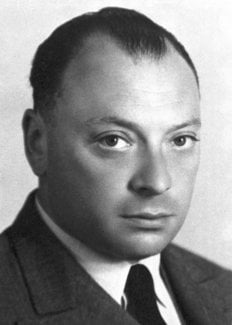Wolfgang Pauli
Biographical

Wolfgang Pauli was born on April 25th, 1900 in Vienna. He received his early education in Vienna before studying at the University of Munich under Arnold Sommerfeld. He obtained his doctor’s degree in 1921 and spent a year at the University of Göttingen as assistant to Max Born and a further year with Niels Bohr at Copenhagen. The years 1923-1928 were spent as a lecturer at the University of Hamburg before his appointment as Professor of Theoretical Physics at the Federal Institute of Technology in Zurich. During 1935-1936, he was visiting Professor at the Institute for Advanced Study, Princeton, New Jersey and he had similar appointments at the University of Michigan (1931 and 1941) and Purdue University (1942). He was elected to the Chair of Theoretical Physics at Princeton in 1940 but he returned to Zurich at the end of World War II.
Pauli was outstanding among the brilliant mid-twentieth century school of physicists. He was recognized as one of the leaders when, barely out of his teens and still a student, he published a masterly exposition of the theory of relativity. His exclusion principle, which is often quoted bearing his name, crystallized the existing knowledge of atomic structure at the time it was postulated and it led to the recognition of the two-valued variable required to characterize the state of an electron. Pauli was the first to recognize the existence of the neutrino, an uncharged and massless particle which carries off energy in radioactive ß-disintegration; this came at the beginning of a great decade, prior to World War II, for his centre of research in theoretical physics at Zurich.
Pauli helped to lay the foundations of the quantum theory of fields and he participated actively in the great advances made in this domain around 1945. Earlier, he had further consolidated field theory by giving proof of the relationship between spin and”statistics” of elementary particles. He has written many articles on problems of theoretical physics, mostly quantum mechanics, in scientific journals of many countries; his Theory of Relativity appears in the Enzyklopaedie der Mathematischen Wissenschaften, Volume 5, Part 2 (1920), his Quantum Theory in Handbuch der Physik, Vol. 23 (1926), and his Principles of Wave Mechanics in Handbuch der Physik, Vol. 24 (1933).
Pauli was a Foreign Member of the Royal Society of London and a member of the Swiss Physical Society, the American Physical Society and the American Association for the Advancement of Science. He was awarded the Lorentz Medal in 1930.
Wolfgang Pauli married Franciska Bertram on April 4th, 1934. He died in Zurich on December 15th, 1958.
This autobiography/biography was written at the time of the award and first published in the book series Les Prix Nobel. It was later edited and republished in Nobel Lectures. To cite this document, always state the source as shown above.
Nobel Prizes and laureates
Six prizes were awarded for achievements that have conferred the greatest benefit to humankind. The 14 laureates' work and discoveries range from quantum tunnelling to promoting democratic rights.
See them all presented here.
